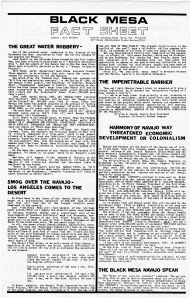“This is Indian land, Indian water, Indian coal, Indian life that is going up in smoke” (Steiner “Black Mesa”).
Such were the words of Stan Steiner, author of various works (i.e. The New Indians, 1968) pertaining to American minority groups including Indians and Mexican-Americans. In fact, Steiner’s “Black Mesa Fact Sheet”—compiled in 1970 at the request of Navajo and Hopi tribal leaders— is included in Volume 1 No. 2 of Rainbow People, a newspaper conveniently found right here in the Alternative Press Collections at the Dodd Center. True to Steiner’s words, Indian life was literally going up in smoke—pollution-related smoke, that is. In 1966, the Navajo Tribal Council granted the Peabody Coal Company the right to explore land in the Black Mesa region of Arizona in order to generate fuel for six large southwestern power plants and for giant polluting cities such as Los Angeles and Phoenix. In exchange, the Navajo received “a mere $600,000 each year for their Nation” (Steiner “Fact Sheet”). However according to Calvin Estitty, a member of the Black Mesa Native Americans, the Navajo had not provided explicit consent to mine—they had simply consented to have the land surveyed (Steiner “Fact Sheet”).
The pollution statistics mentioned in Steiner’s fact sheet are jarring: “Sulfur dioxide emissions of 735 tons a day (267,275 tons a year). That is more than three times the health hazard […] that L.A. people suffer.” Additionally, the fly ash particle emissions of 137 tons a day were well above the LA statistic (109 /day) and almost as high as New York’s 140 tons. Indeed, the Navajo plant alone was estimated to “fill [the] sky [with] 465,125 tons of smog yearly” (Steiner “Fact Sheet”).
The Hopis, too, signed a 99-year lease with the company to strip-mine coal in Black Mesa (Committee of Concern). However the concerns amongst both native groups were not limited to air-pollution. Steiner goes so far as to criticize the New York Times’ coverage of Black Mesa as insufficient, seeing its failure to address the religious implications of strip-mining. Indeed, Black Mesa (the “Female Mountain”) has traditionally been considered a symbol of beauty, harmony, and the Navajo way. Some Navajos saw this as an example of how the “white man has unthinkingly defiled the religious belief of the Indians. He has disrupted the sacred and holy mountains” (Steiner “Fact Sheet”). The economic concerns were also significant. As one Navajo Tribal leader put it: “What will be left of our way of life? No pastures for our sheep! No jobs when the Mesa is gone! They force us into colonial economy (qtd. in Steiner “Fact Sheet”).
Although there are still groups like Black Mesa Indigenous Support that aid “the indigenous peoples of Black Mesa in their resistance to massive coal mining operations” (“Mission Statement”), Peabody Energy currently maintains the Kayenta Mine in the region. The company asserts that its “environmental and community practices on Black Mesa were recognized as a world model for sustainability” (“Southwest Operations”).
Although Steiner argues that the concerns of these “invisible” indigenous peoples are “lost in the smog” (“Black Mesa”) when being addressed in major newspapers, they can still be found right here—preserved and waiting to be read in the APC.
Krisela Karaja, Student Intern
Resources:
The Committee of Concern for the Traditional Indian. “Hopi: Black Mesa.” Rainbow People [John Day, Oregon] Vol. 1. No. 2. 1970: p. 6. Print. Alternative Press Collections. Archives and Special Collections at the Thomas J. Dodd Research Center, University of Connecticut Libraries.
Hill, Gladwin. “Arizona Strip-Mining Project Leaving Navajo Land Unscarred.” New York Times 24 Jan. 1971: p. 55. Proquest
Historical Newspapers. Web. 26 Oct 2011.
“Mission Statement.” Black Mesa Indigenous Support. BMIS. Web. 21 Oct. 2011. http://blackmesais.org/about/mission/.
“Southwest Operations.” Peabody Energy. Peabody Energy, Inc. Web. 26 Oct. 2011.
< http://www.peabodyenergy.com/content/247/US-Mining/Powder-River-Basin-and-Southwest>.
Steiner, Stan. “Black Mesa” (letter to the editor of the New York Times). Rainbow People [John Day, Oregon] Vol. 1. No. 2. 1971: p. 14. Print. Alternative Press Collections. Archives and Special Collections at the Thomas J. Dodd Research Center, University of Connecticut Libraries.
Steiner, Stan. “Black Mesa Fact Sheet.” Rainbow People [John Day, Oregon] Vol. 1. No. 2. 1970: p. 8. Print. Alternative Press Collections. Archives and Special Collections at the Thomas J. Dodd Research Center, University of Connecticut Libraries.

